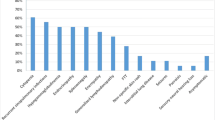Abstract
The recombination activating gene 1 (RAG1) is essential for V(D)J recombination during T- and B-cell development. In this study, we presented a case study of a 41-day-old female infant who exhibited symptoms of generalized erythroderma, lymphadenopathy, hepatosplenomegaly, and recurrent infections including suppurative meningitis and septicemia. The patient showed a T+B−NK+ immunophenotype. We observed an impaired thymic output, as indicated by reduced levels of naive T cells and sjTRECs, coupled with a restricted TCR repertoire. Additionally, T-cell CFSE proliferation was impaired, indicating a suboptimal T-cell response. Notably, our data further revealed that T cells were in an activated state. Genetic analysis revealed a previously reported compound heterozygous mutation (c. 1186C > T, p. R396C; c. 1210C > T, p. R404W) in the RAG1 gene. Structural analysis of RAG1 suggested that the R396C mutation might lead to the loss of hydrogen bonds with neighboring amino acids. These findings contribute to our understanding of RAG1 deficiency and may have implications for the development of novel therapies for patients with this condition.






Similar content being viewed by others
Data availability
Not applicable.
References
Aleman K et al (2001) Reviewing Omenn syndrome. Eur J Pediatr 160(12):718–725
Ali B et al (2016) In silico analysis of green tea polyphenols as inhibitors of AChE and BChE enzymes in Alzheimer’s disease treatment. CNS Neurol Disord Drug Targets 15(5):624–628
Corneo B et al (2001) Identical mutations in RAG1 or RAG2 genes leading to defective V(D)J recombinase activity can cause either T-B-severe combined immune deficiency or Omenn syndrome. Blood 97(9):2772–2776
Delmonte OM, Schuetz C, Notarangelo LD (2018) RAG deficiency: two genes, many diseases. J Clin Immunol 38(6):646–655
Delmonte OM, Villa A, Notarangelo LD (2020) Immune dysregulation in patients with RAG deficiency and other forms of combined immune deficiency. Blood 135(9):610–619
Ding Y et al (2018) Reference values for peripheral blood lymphocyte subsets of healthy children in China. J Allergy Clin Immunol 142(3):970–973, e8
Kuo TC, Schlissel MS (2009) Mechanisms controlling expression of the RAG locus during lymphocyte development. Curr Opin Immunol 21(2):173–178
Lee YN et al (2014) A systematic analysis of recombination activity and genotype-phenotype correlation in human recombination-activating gene 1 deficiency. J Allergy Clin Immunol 133(4):1099–1108
Mou W et al (2021a) A novel homozygous TTC7A missense mutation results in familial multiple intestinal atresia and combined immunodeficiency. Front Immunol 12:759308
Mou W et al (2021b) Compound heterozygous DCLRE1C mutations lead to clinically typical severe combined immunodeficiency presenting with graft versus host disease. Immunogenetics 73(6):425–434
Notarangelo LD et al (2016) Human RAG mutations: biochemistry and clinical implications. Nat Rev Immunol 16(4):234–246
Santagata S et al (2000) The genetic and biochemical basis of Omenn syndrome. Immunol Rev 178:64–74
Schatz DG, Swanson PC (2011) V(D)J recombination: mechanisms of initiation. Annu Rev Genet 45:167–202
van der Burg M, Gennery AR (2011) Educational paper. The expanding clinical and immunological spectrum of severe combined immunodeficiency. Eur J Pediatr 170(5):561–71
Villa A et al (1998) Partial V(D)J recombination activity leads to Omenn syndrome. Cell 93(5):885–896
Villa A et al (1999) Omenn syndrome: a disorder of Rag1 and Rag2 genes. J Clin Immunol 19(2):87–97
Villa A, Notarangelo LD, Roifman CM (2008) Omenn syndrome: inflammation in leaky severe combined immunodeficiency. J Allergy Clin Immunol 122(6):1082–1086
Wada T et al (2000) Characterization of immune function and analysis of RAG gene mutations in Omenn syndrome and related disorders. Clin Exp Immunol 119(1):148–155
Yin FF et al (2009) Structure of the RAG1 nonamer binding domain with DNA reveals a dimer that mediates DNA synapsis. Nat Struct Mol Biol 16(5):499–508
Funding
This work was partially supported by funding from the National Key Research and Development Program of China (No. 2022YFC2704802).
Author information
Authors and Affiliations
Contributions
WJM, JGG, YJW, ZXY, and MYH conceived and designed the study. All authors contributed to data collection and analysis. WJM drafted the manuscript and all authors approved the final manuscript.
Corresponding authors
Ethics declarations
Ethical approval
This study was approved by the Ethics Committee of the Beijing Children’s Hospital, Capital Medical University. The signed consent was obtained from the parents.
Conflict of interest
The authors declare no competing interests.
Additional information
Publisher's Note
Springer Nature remains neutral with regard to jurisdictional claims in published maps and institutional affiliations.
Rights and permissions
Springer Nature or its licensor (e.g. a society or other partner) holds exclusive rights to this article under a publishing agreement with the author(s) or other rightsholder(s); author self-archiving of the accepted manuscript version of this article is solely governed by the terms of such publishing agreement and applicable law.
About this article
Cite this article
Mou, W., Yang, Z., Wang, X. et al. Immunological assessment of a patient with Omenn syndrome resulting from compound heterozygous mutations in the RAG1 gene. Immunogenetics 75, 385–393 (2023). https://doi.org/10.1007/s00251-023-01309-5
Received:
Accepted:
Published:
Issue Date:
DOI: https://doi.org/10.1007/s00251-023-01309-5




